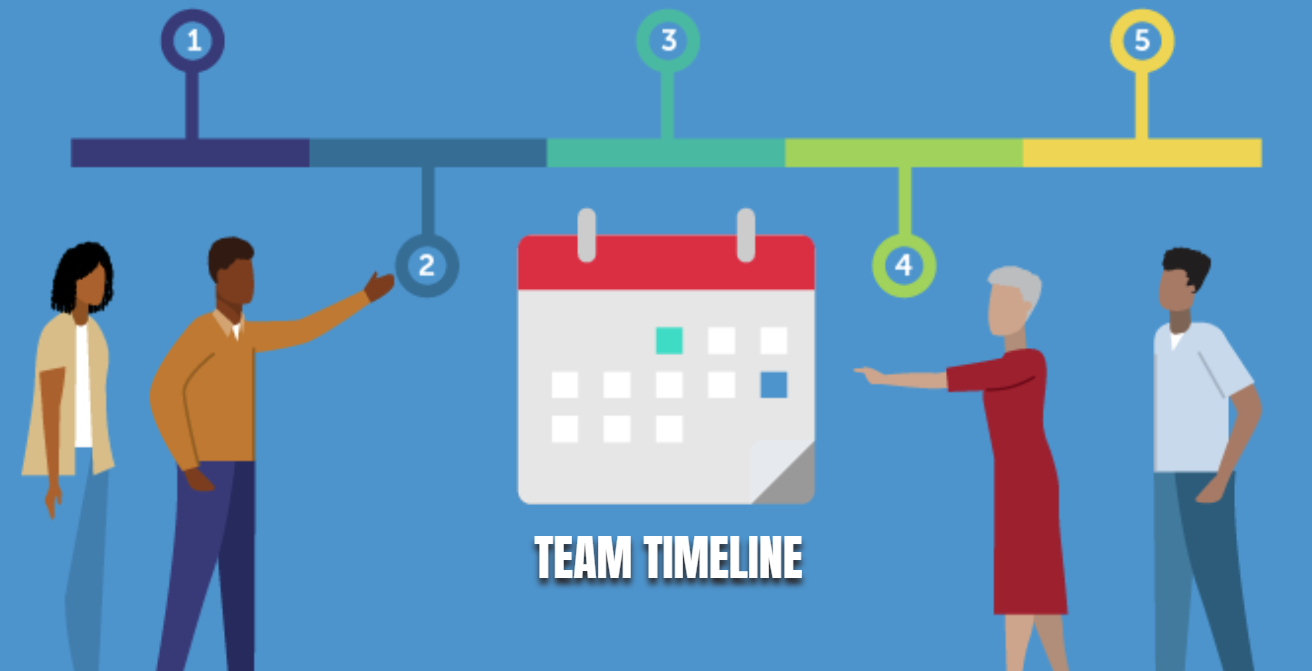Team Timeline: A Comprehensive Guide to Effective Project Management and Collaboration
In the fast-paced world of business and project management, keeping track of tasks, deadlines, and responsibilities is crucial to success. One of the most effective tools for achieving this is a team timeline.
This comprehensive guide will explore the concept of a team timeline, its importance, best practices for implementation, and how it can enhance collaboration and productivity within teams.
Whether you’re managing a small project or overseeing a large-scale operation, understanding how to effectively use a team timeline can make all the difference in achieving your goals.
What is a Team Timeline?
Definition and Overview
A team timeline is a visual representation of the tasks, milestones, and deadlines within a project, organized in a chronological order. It provides a clear view of what needs to be done, who is responsible for each task, and when those tasks are due. By offering a bird’s-eye view of the entire project, a team timeline helps teams stay organized, aligned, and on track.
The concept of a team timeline can be applied in various contexts, from project management to product development, marketing campaigns, event planning, and more. It is an essential tool for ensuring that all team members are aware of their responsibilities and how their work fits into the larger picture.
The Purpose of a Team Timeline
The primary purpose of a team timeline is to facilitate effective project management by providing a clear and organized structure for tracking progress. It serves several key functions:
- Scheduling and Planning: A team timeline helps in scheduling tasks, setting deadlines, and planning resources. It allows project managers to allocate time and resources efficiently, ensuring that everything is done on time and within budget.
- Communication and Transparency: By making the timeline visible to all team members, it enhances communication and transparency. Everyone knows what’s expected of them and when, reducing the chances of misunderstandings and missed deadlines.
- Tracking Progress: A team timeline allows for real-time tracking of progress, making it easier to identify potential bottlenecks or delays. This enables timely interventions to keep the project on track.
- Motivating the Team: Seeing a clear timeline with achievable milestones can motivate team members to stay focused and committed. It provides a sense of direction and purpose, helping to maintain momentum throughout the project.
The Importance of a Team Timeline in Project Management
Enhancing Team Collaboration
One of the most significant benefits of a team timeline is its ability to enhance collaboration within the team. By clearly outlining each team member’s responsibilities and deadlines, it ensures that everyone is on the same page. This collaborative approach fosters a sense of accountability and encourages team members to work together towards a common goal.
A well-structured team timeline also helps in coordinating efforts across different departments or functions. For example, in a product development project, the timeline might show how the work of the design team intersects with that of the engineering and marketing teams. This cross-functional visibility is crucial for ensuring that all parts of the project are aligned and progressing in harmony.
Improving Time Management
Time management is a critical aspect of any project, and a team timeline plays a vital role in this area. By setting clear deadlines and milestones, it helps teams prioritize tasks and manage their time effectively. This is particularly important in complex projects where multiple tasks need to be completed simultaneously.
A team timeline also allows for better management of dependencies, where the completion of one task is contingent on the completion of another. By visualizing these dependencies, teams can plan more effectively and avoid potential delays.
Reducing Stress and Uncertainty
Projects can often be stressful, especially when deadlines are tight, and the scope is broad. A team timeline helps to reduce this stress by providing a clear and organized structure for managing tasks. When team members know what is expected of them and when, it reduces uncertainty and allows them to focus on their work without the constant worry of missing deadlines.
Moreover, a team timeline can help identify potential risks or challenges early in the project. By tracking progress in real-time, project managers can spot delays or issues before they escalate, allowing for timely interventions and reducing the likelihood of project failure.
Facilitating Better Decision-Making
A team timeline provides valuable data that can inform decision-making throughout the project. For example, if the timeline shows that certain tasks are consistently behind schedule, it might indicate a need for additional resources or a change in strategy. Similarly, if certain milestones are met ahead of schedule, it might allow the team to accelerate other parts of the project or take on additional work.
By providing a clear and objective view of the project’s progress, a team timeline enables project managers and team members to make informed decisions that enhance the overall success of the project.
Best Practices for Creating and Managing a Team Timeline
Defining Clear Objectives and Milestones
The first step in creating an effective team timeline is to define clear objectives and milestones. These should be specific, measurable, achievable, relevant, and time-bound (SMART). By setting clear goals, you provide the team with a clear direction and a sense of purpose.
Milestones are critical checkpoints within the project that indicate significant progress. They should be strategically placed throughout the timeline to break the project into manageable phases. This not only helps in tracking progress but also keeps the team motivated by providing a sense of accomplishment as each milestone is reached.
Assigning Responsibilities
A team timeline is only effective if everyone knows what they are responsible for. Assigning responsibilities clearly and early in the project is essential. Each task on the timeline should have an owner—someone who is accountable for its completion.
It’s also important to ensure that responsibilities are balanced and realistic. Overloading team members with too many tasks can lead to burnout and decreased productivity. Instead, aim for a fair distribution of work that takes into account each team member’s skills and capacity.
Prioritizing Tasks
Not all tasks are created equal, and some will have a greater impact on the project’s success than others. A well-designed team timeline should prioritize tasks based on their importance and urgency. High-priority tasks should be scheduled first, with adequate time and resources allocated to ensure their completion.
Prioritizing tasks also helps in managing dependencies. Tasks that are critical for the completion of other tasks should be prioritized to prevent bottlenecks and delays.
Setting Realistic Deadlines
Deadlines are a crucial component of any team timeline, but they must be realistic. Unrealistic deadlines can lead to unnecessary stress, lower quality work, and missed deadlines. When setting deadlines, consider factors such as the complexity of the task, the availability of resources, and the team’s capacity.
It’s also important to build some flexibility into the timeline. Unexpected challenges or changes in scope are common in projects, so having some buffer time can help accommodate these without derailing the entire project.
Regularly Updating the Timeline
A team timeline is not a static document; it should be regularly updated to reflect the project’s progress and any changes that occur. Regular updates ensure that the timeline remains accurate and relevant, providing the team with up-to-date information on what needs to be done.
Regular updates also allow for adjustments to be made in response to changes in the project. For example, if a task is taking longer than expected, the timeline can be adjusted to reflect the new reality, and resources can be reallocated as needed.
Using Project Management Tools
There are many project management tools available that can help in creating and managing a team timeline. Tools like Trello, Asana, Microsoft Project, and Monday.com offer features such as drag-and-drop task management, real-time collaboration, and progress tracking.
Using these tools can enhance the effectiveness of your team timeline by making it more interactive and accessible. Team members can easily update their tasks, communicate with each other, and track progress in real-time, all within the same platform.
The Role of a Team Timeline in Different Industries
Team Timelines in Software Development
In software development, a team timeline is essential for managing complex projects that involve multiple teams working on different aspects of the product. The timeline helps in coordinating efforts between developers, designers, testers, and other stakeholders, ensuring that all parts of the project are aligned and progressing on schedule.
Agile methodologies, such as Scrum, often use timelines in the form of sprints, where the project is broken down into short, manageable phases. Each sprint has its own timeline, with tasks and deadlines clearly defined, allowing the team to focus on specific goals and deliverables.
Team Timelines in Marketing Campaigns
Marketing campaigns often involve multiple channels, teams, and deliverables, making a team timeline an invaluable tool for managing these efforts. The timeline can map out the entire campaign, from the initial planning stages to execution and post-campaign analysis.
A team timeline in marketing might include tasks such as content creation, social media scheduling, email marketing, and analytics tracking. By organizing these tasks into a clear timeline, the marketing team can ensure that all elements of the campaign are delivered on time and in a coordinated manner.
Team Timelines in Event Planning
Event planning is another area where a team timeline is crucial. Whether it’s a corporate event, a conference, or a wedding, there are countless tasks that need to be coordinated and completed by specific deadlines.
A team timeline for event planning might include tasks such as venue booking, vendor coordination, marketing, ticket sales, and logistics. By visualizing all these tasks on a timeline, the event planning team can manage the project more effectively, ensuring that everything is ready by the day of the event.
Team Timelines in Construction Projects
Construction projects are complex endeavors that require careful planning and coordination. A team timeline is essential for managing the various stages of the project, from initial design and permitting to construction and final inspections.
The timeline in construction projects helps in coordinating the efforts of architects, engineers, contractors, and suppliers, ensuring that all parts of the project are completed in the correct order and on schedule. It also allows for better management of resources, such as labor and materials, by providing a clear view of when and where they are needed.
Challenges and Solutions in Managing a Team Timeline
Common Challenges
While a team timeline is a powerful tool, managing it effectively can be challenging. Some common challenges include:
- Scope Creep: As projects progress, there’s often a tendency for the scope to expand, with new tasks and objectives being added. This can make the timeline more complex and harder to manage.
- Resource Constraints: Limited resources, whether in terms of time, budget, or personnel, can strain the timeline and lead to delays.
- Communication Gaps: Poor communication can lead to misunderstandings and misalignment, making it difficult to keep the timeline on track.
- Unforeseen Challenges: Unexpected challenges, such as technical issues or external factors, can disrupt the timeline and require quick adjustments.
Solutions and Best Practices
To overcome these challenges, consider the following solutions:
- Regularly Review and Adjust the Timeline: Regular reviews help in identifying potential issues early and allow for timely adjustments.
- Prioritize Clear Communication: Ensure that all team members are aware of their responsibilities and deadlines, and encourage open communication to resolve any issues quickly.
- Manage Resources Effectively: Plan resource allocation carefully, and be prepared to reallocate resources as needed to keep the project on track.
- Prepare for Contingencies: Build flexibility into the timeline to accommodate unexpected challenges without derailing the entire project.
FAQs About Team Timeline
1. What is a team timeline?
A team timeline is a visual representation of the tasks, milestones, and deadlines within a project, organized chronologically. It helps teams manage their time, resources, and responsibilities effectively.
2. How do you create an effective team timeline?
To create an effective team timeline, start by defining clear objectives and milestones, assigning responsibilities, prioritizing tasks, setting realistic deadlines, and regularly updating the timeline to reflect progress.
3. What tools can be used to manage a team timeline?
There are several project management tools available, such as Trello, Asana, Microsoft Project, and Monday.com, that offer features for creating and managing a team timeline.
4. How does a team timeline improve collaboration?
A team timeline improves collaboration by providing a clear view of each team member’s responsibilities and deadlines, enhancing communication and ensuring that all parts of the project are aligned.
5. What are the challenges of managing a team timeline?
Challenges in managing a team timeline include scope creep, resource constraints, communication gaps, and unforeseen challenges. Regular reviews, clear communication, effective resource management, and contingency planning can help overcome these challenges.
Conclusion: The Power of an Effective Team Timeline
A well-structured team timeline is an invaluable tool for managing projects of any size or complexity. It enhances collaboration, improves time management, reduces stress, and facilitates better decision-making. By following best practices and addressing common challenges, you can leverage a team timeline to keep your projects on track and ensure their successful completion.
Whether you’re working in software development, marketing, event planning, or any other field, a team timeline provides the organization and structure needed to achieve your goals efficiently and effectively. Embrace the power of a team timeline in your project management strategy, and watch as your team’s productivity and success soar.






